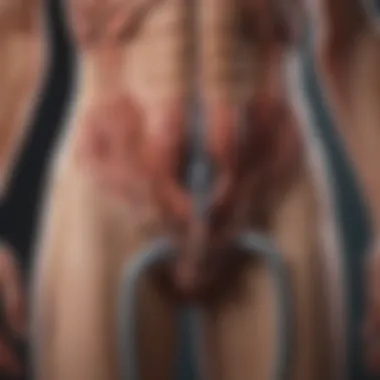Understanding the Causes of Frequent Urination


Intro
Frequent urination, or polyuria, is a complex condition that affects many individuals across diverse age groups. This condition is often overlooked due to its commonality, yet its implications on health can be significant. Understanding the multifaceted reasons behind increased urination is crucial. Multiple factors can contribute to this issue, ranging from physiological changes to diet and underlying medical conditions. It is important for health professionals, wellness coaches, and even fitness trainers to grasp these aspects for effective management and patient care.
This article seeks to deconstruct the causes of frequent urination, offering insights into both established and lesser-known reasons. By addressing symptoms, physiological responses, and potential treatments, the article aims to shed light on this often misunderstood aspect of health. Armed with the right information, professionals can develop comprehensive strategies to assist individuals who struggle with this condition.
Key Takeaways
- Frequent urination can be caused by various factors, including diabetes, urinary tract infections, and overactive bladder.
- Understanding physiological mechanisms is essential for accurate diagnosis and management.
- Lifestyle changes, medical interventions, and dietary adjustments can significantly alleviate symptoms.
- Increased awareness of this condition can lead to better health outcomes and improved quality of life.
By recognizing these key points, readers can engage more deeply with the content and consider the approaches outlined for managing frequent urination effectively.
Defining Frequent Urination
Frequent urination, termed polyuria, is more than just a minor inconvenience; it is an important health indicator that can signify various underlying conditions. Defining frequent urination accurately is crucial for understanding its implications and potential consequences on well-being. This section lays the groundwork for a deeper exploration into the causes and effects of excessive urination. It also assists health professionals in identifying when to investigate further or adjust treatment plans.
What Is Polyuria?
Polyuria refers to the condition of producing an abnormally large volume of urine. Typically, this constitutes urination that exceeds three liters per day in adults. This can often lead to a significant disruption in daily life, affecting personal and professional commitments.
Some common characteristics associated with polyuria may include:
- The need to urinate several times during the night, known as nocturia.
- Increased thirst or polydipsia, which often occurs as the body attempts to compensate for the loss of fluids.
- A sense of urgency to void, often with little warning.
Understanding polyuria is essential for diagnosing various health issues such as diabetes mellitus, kidney disorders, or hormonal imbalances.
Normal Urination Frequency
Normal urination frequency varies among individuals, but generally, a healthy adult may urinate between six to eight times per day. Factors that influence individual urination frequency include:
- Fluid intake: The more fluids consumed, the more frequent urination tends to be.
- Diet: Certain foods and beverages, particularly those high in caffeine or alcohol, can stimulate the bladder.
- Physical activity: Increased perspiration during exercise often leads to less urine output, but post-activity can result in increased need to urinate.
It is important to differentiate between normal fluctuations in urination and the abnormalities associated with polyuria. Awareness of what constitutes normal helps professionals and caregivers recognize potential health warnings.
Physiological Mechanisms of Urination
Understanding the physiological mechanisms behind urination is crucial for grasping the complexities associated with frequent urination. The human body employs several systems that ensure proper fluid balance and waste elimination. These systems are intricately connected, allowing for precise control of urine production and voiding. A deep dive into these mechanisms reveals significant insight into why frequent urination occurs and how it may be managed.
Role of Kidneys
The kidneys are central to the regulation of urination. They filter blood, removing waste products, excess substances, and minerals. This filtering process results in the production of urine, which is stored in the bladder until it is eliminated from the body. The primary functions of the kidneys include:
- Filtration of Blood: This is the first and most critical function, where waste and excess fluids are removed from the bloodstream.
- Regulation of Electrolytes: Maintaining the balance of electrolytes like sodium and potassium is vital for overall health.
- Acid-Base Balance: The kidneys help maintain the body’s pH level by excreting hydrogen ions and reabsorbing bicarbonate.
Any disturbance in kidney function can lead to changes in urine volume and frequency. Conditions such as chronic kidney disease or acute kidney injury can significantly increase urine output, leading to polyuria.
Hormonal Regulation
Hormones play a crucial role in managing how much urine is produced. Two primary hormones influence these processes: antidiuretic hormone (ADH) and aldosterone.
- Antidiuretic Hormone (ADH): Released by the pituitary gland, ADH signals the kidneys to reabsorb water. When ADH levels are low, more water is excreted, leading to increased urine production.
- Aldosterone: This hormone helps regulate sodium and water balance. It promotes sodium reabsorption in the kidneys, which indirectly leads to water retention. Low levels of aldosterone can result in frequent urination due to reduced water retention.
Understanding the hormonal influences on urination is crucial, especially in conditions such as diabetes insipidus, where hormone levels are disrupted, leading to excessive urination.
Bladder Functionality


The bladder acts as a reservoir for urine before it is expelled from the body. Its functionality is vital in determining urination frequency. The bladder has several important features:
- Elastic Capacity: The bladder can stretch to accommodate varying volumes of urine, but its elasticity may be compromised in some conditions, leading to frequent urges to urinate.
- Neural Control: The bladder is controlled by a combination of voluntary and involuntary nerves. If there is a problem with the nerves that signal when to empty the bladder, it can result in either urgency or difficulty in urination.
- Muscle Function: The detrusor muscle contracts to expel urine. If the muscle is overactive, it can cause increased urination frequency.
Frequent urination can be a symptom of multiple conditions, affecting quality of life greatly. Assessing the bladder’s functionality alongside kidney and hormonal assessments is essential in understanding the issue.
Common Causes of Frequent Urination
Understanding the common causes of frequent urination is crucial as it helps identify underlying health concerns. This section delves into various factors that might lead to increased urination. Knowing these causes can guide practitioners in forming appropriate treatment plans. It can also help patients recognize symptoms that require attention.
Frequent urination can lead to disruption in daily activities and significantly impact quality of life. Therefore, comprehending these root causes allows for early intervention, potentially preventing more severe health complications down the line.
Diabetes Mellitus
One of the primary contributors to frequent urination is diabetes mellitus. This condition affects the body's ability to utilize glucose properly. As blood sugar levels rise, kidneys work to filter excess glucose. This process results in increased urine production. This can manifest as polyuria, causing patients to visit the bathroom often.
There are two main types of diabetes. Type 1 is typically diagnosed in children and adolescents, while Type 2 is more common in adults, often associated with lifestyle factors like obesity. Both types can lead to similar urinary symptoms if not controlled effectively.
Urinary Tract Infections
Urinary tract infections (UTIs) are another significant cause of frequent urination. These infections can occur in the bladder or urethra, irritating the urinary system. Symptoms usually include a strong urgency to urinate, a burning sensation, and cloudy urine.
Women are more susceptible to UTIs due to anatomical differences. However, men can also experience these infections. Treatment often involves antibiotics, but understanding the underlying factors that contribute to UTIs can help in prevention. Hydration is vital, as it can flush bacteria from the urinary tract.
Prostate Issues
In men, issues with the prostate can significantly influence urination patterns. Conditions such as benign prostatic hyperplasia (BPH) can lead to an enlarged prostate. This enlargement can compress the urethra, resulting in a frequent need to urinate.
Other prostate-related issues include prostatitis and prostate cancer. Regular check-ups and examinations can catch these prostate concerns early and help manage symptoms effectively.
Fluid Intake and Hydration
One of the simplest causes of frequent urination relates to fluid intake and hydration habits. Drinking large quantities of fluids, especially diuretics like caffeine and alcohol, can naturally lead to increased urination.
While staying hydrated is essential for overall health, it is critical to balance intake to avoid unnecessary bathroom trips. Individuals must be aware of their daily fluid intake to regulate urination better. A focused approach to hydration can improve comfort and prevent disruptions in daily routines.
Less Known Causes of Frequent Urination
Understanding the less known causes of frequent urination is essential for a comprehensive view of this condition. While common conditions like diabetes and urinary tract infections often dominate discussions, there are other significant contributors worth exploring. Recognizing these lesser-known causes can lead to more accurate diagnosis and effective management strategies. For health professionals, wellness coaches, and fitness trainers, a nuanced understanding of these factors can aid in providing informed guidance to individuals experiencing polyuria.
Neurological Disorders
Neurological disorders can significantly impact urination frequency. Conditions such as multiple sclerosis and Parkinson’s disease often interfere with the nerves that control bladder function. For individuals with these disorders, signals to the bladder may become erratic. As a consequence, the bladder may not empty completely, leading to a sensation of urgency. This can create a cycle of frequent urination, where the body is misinterpreting signals, prompting individuals to feel the need to urinate frequently. Understanding this relationship is crucial for developing tailored approaches that address both the neurological condition and its urinary manifestations.
Medications and Diuretics
Certain medications, particularly diuretics, can increase urination frequency. Diuretics, often prescribed for conditions like hypertension or edema, work by prompting the kidneys to remove excess fluid from the body. While effective for managing fluid retention, they can lead to increased urination, particularly in patients unaccustomed to their effects. Additionally, some medications may cause side effects that mimic the sensation of needing to urinate more frequently. It is important for clinicians to assess the medication histories of patients complaining of polyuria. This evaluation can help distinguish between side effects of medications and other underlying health issues.
Pregnancy and Hormonal Changes
During pregnancy, hormonal fluctuations and physical changes can lead to increased urination. Increased levels of hormones such as human chorionic gonadotropin (hCG) and progesterone can affect bladder function. Additionally, as the uterus expands, it can put pressure on the bladder, reducing its capacity and leading to a higher urge to urinate. Health practitioners advising pregnant women need to recognize this normal physiological response, ensuring that patients understand it is common and often temporary. Monitoring these changes is still necessary, as some women may experience urinary tract infections or other complications during pregnancy.
Chronic Conditions
Chronic conditions such as chronic kidney disease or heart failure can influence urination patterns. Individuals with chronic kidney disease often struggle with fluid balance, resulting in increased urination as the kidneys attempt to expel excess fluids. Similarly, heart failure can lead to fluid retention, which may subsequently result in the need to urinate more frequently, especially at night. Recognizing these conditions is vital for healthcare providers, as it informs them to take an integrative approach to treatment that addresses not only the increased urination but the management of the underlying chronic conditions.


It is important for healthcare providers to consider these less known factors in their assessment of frequent urination.
This detailed approach allows for better patient-centric strategies that encompass both the symptoms and the root causes of frequent urination.
Impact of Frequent Urination on Daily Life
Frequent urination, medically known as polyuria, significantly affects daily functioning and quality of life. Understanding its impact is essential for those experiencing this condition, as it can lead to physical discomfort as well as psychological challenges. Recognizing these factors can guide individuals toward seeking appropriate treatment and implementing effective management strategies.
Physical Discomfort
Frequent urination often brings various physical discomforts. Individuals may experience an urgent need to relieve themselves, which can lead to interrupted activities. It can hinder normal routines, such as work or social engagements. Nocturia, or the need to urinate at night, disrupts sleep patterns, which in turn affects overall health. Sleep deprivation may lead to fatigue, decreased alertness, and difficulty concentrating during the day.
Moreover, condition-specific discomfort can arise. For instance, urinary tract infections may cause burning sensations during urination, accentuating the physical distress. Thus, addressing frequent urination is not just about managing trips to the restroom; it is also about mitigating the physical pain and discomfort that can accompany this condition.
Psychological Effects
The implications of frequent urination extend well beyond the physical realm. Psychologically, individuals may grapple with anxiety and stress. The constant need to urinate can create a sense of insecurity, particularly in social settings, leading to social withdrawal or avoidance behaviors. In severe cases, the fear of not being able to find a restroom can impact lifestyle choices, including travel and recreation.
Additionally, persistent shame or embarrassment from frequent urination may lead to feelings of isolation. Such emotional burdens can heighten existing mental health issues or even contribute to the development of new ones, such as depression. The complexity of effects emphasizes the necessity to address both the physical and psychological aspects of polyuria.
Frequent urination can alter daily life in ways that impact personal, social, and professional aspects profoundly, necessitating a comprehensive approach to management.
Diagnosis of Frequent Urination
Diagnosis is a crucial step in understanding frequent urination, also known as polyuria. Recognizing the underlying causes is essential for effective management. A comprehensive diagnosis can bring clarity to a complex issue, helping to differentiate between normal variations in urination and symptoms indicative of a potential medical condition.
Accurate diagnosis involves a combination of medical history assessment, physical examinations, and laboratory tests. Each component provides valuable insights and can significantly influence the treatment plan. Understanding these elements is vital for health professionals to ensure that patients receive tailored care based on their specific situations.
Medical History Assessment
The medical history assessment is often the first step in diagnosing frequent urination. It involves gathering information about the patient’s background, symptoms, lifestyle, and medical conditions. Key areas to focus on include:
- Urinary Symptoms: Details regarding the frequency, urgency, and any associated discomfort.
- Fluid Intake: Daily consumption of fluids, including caffeine and alcohol, which can impact urination.
- Medications: Any current or past medications that may contribute to increased urination.
- Pre-existing Conditions: Conditions such as diabetes or kidney issues that might link to urination changes.
A thorough medical history can help identify patterns and triggers, aiding in the diagnostic process and guiding further examination.
Physical Examination
Following the medical history assessment, a physical examination is performed. This process can uncover signs that may not be immediately evident or reported by the patient. Important aspects of the physical examination include:
- Vital Signs: Monitoring blood pressure and heart rate can indicate underlying stress or dehydration.
- Abdominal Examination: Checking for tenderness or abnormalities that may relate to bladder or kidney issues.
- Pelvic Examination: In certain cases, examining the pelvic region may be necessary to assess urinary tract health.
The physical examination provides a holistic view of the patient’s health and can often reveal additional issues that require attention.
Laboratory Tests
Laboratory tests are a fundamental aspect of diagnosing frequent urination. They help confirm or exclude potential causes. Common tests include:
- Urine Analysis: Assessing urine samples can reveal infections, blood, or other abnormalities.
- Blood Tests: Measuring glucose levels and kidney function can indicate diabetes or renal issues.
- Imaging Studies: In some cases, ultrasound or other imaging methods are needed to visualize the urinary tract.
These tests deliver concrete data, enabling healthcare providers to make informed decisions regarding diagnosis and treatment options, leading to a more effective management strategy for polyuria.
Diagnosis is key not just for understanding frequent urination, but for ensuring patients receive the most appropriate care tailored to their unique challenges.
Management Strategies for Frequent Urination


Managing frequent urination requires a thorough understanding of its complexities and underlying causes. The strategies employed should focus on alleviating symptoms and addressing the root problems. This section discusses lifestyle modifications, medications, and behavioral therapies, offering a multi-faceted approach to care that emphasizes both immediate relief and long-term management.
Such strategies are not merely for symptom relief; they also play a pivotal role in enhancing the quality of life. Individuals suffering from frequent urination often experience physical discomfort and psychological distress. Therefore, effective management becomes essential not only for health but also for emotional well-being.
Lifestyle Modifications
Making simple adjustments in daily life can significantly reduce the frequency of urination. Here are some of the key considerations:
- Fluid Management: Monitoring and potentially reducing fluid intake, especially before bedtime, can help. This is critical as drinking large quantities of fluids close to sleeping hours can lead to disrupted sleep patterns due to the urge to urinate.
- Dietary Changes: Some foods can irritate the bladder. It is advisable to limit intake of caffeine, alcohol, and acidic fruits like oranges and grapefruits. Instead, focus on a balanced diet enriched with fiber and low in irritants, supporting overall bladder health.
- Scheduled Bathroom Breaks: Creating a bathroom schedule can help manage the urge. Sittiing at intervals to empty the bladder can make it easier to control the frequency during the day.
These modifications ease discomfort, enhance control over bladder habits, and improve overall quality of life.
Medications and Treatments
In some instances, lifestyle changes may not suffice, and medications become necessary. Here are some common treatment options:
- Anticholinergics: These drugs help reduce bladder contractions, making it easier to manage frequent urges. Oxybutynin and Tolterodine are typical examples that can provide relief.
- Beta-3 Agonists: Medications like Mirabegron can help by relaxing the bladder muscle, increasing storage capacity.
- Hormonal Treatments: For some, particularly post-menopausal women, hormonal adjustments might be required. Estrogen creams may support against bladder irritations caused by hormonal changes.
Prescribing medication should always be guided by a healthcare provider's analysis of individual needs and symptoms. Therefore, a tailored treatment plan is crucial for effective management.
Behavioral Therapies
Incorporating psychological elements into managing frequent urination can yield positive outcomes. Here are key behavioral therapies:
- Bladder Training: This therapy involves learning to delay urination after the first urge. Over time, it aims to increase the bladder's capacity and reduce the frequency of trips to the bathroom.
- Pelvic Floor Muscle Exercises: Kegel exercises strengthen pelvic muscles, providing better control over urination. Consistent practice can lead to remarkable improvements in managing bladder function.
- Cognitive Behavioral Therapy (CBT): For individuals experiencing anxiety related to incontinence or frequent urination, CBT can help address the mental aspects thereof. It can aid in reducing fears and minimizing the impact of symptoms on day-to-day activities.
Adopting these strategies requires diligence and commitment. However, with the right mix and consistency, significant improvements can be achieved, leading to a better handle on frequent urination.
When to Seek Medical Advice
Understanding when to seek medical advice regarding frequent urination is crucial. Symptoms do not always indicate a serious issue, but in certain cases, they may signal an underlying condition that requires prompt attention. Frequent urination, especially when accompanied by other symptoms, should not be overlooked. Early intervention can lead to more effective treatment and better outcomes.
Identifying Warning Signs
When it comes to recognizing warning signs, observers should be vigilant about changes in urination patterns. Important indications include:
- Significant increase in frequency over a short period.
- Pain or discomfort during urination.
- Presence of blood in the urine.
- Urgency that feels overwhelming or uncontrollable.
- Accompanying symptoms such as fever, fatigue, or unexplained weight loss.
These signs suggest that an evaluation by a healthcare professional is necessary. It may point to various conditions such as infections or diabetes. Ignoring these symptoms can lead to worsening health issues.
Regular Check-Ups
Regular medical check-ups play a significant role in maintaining urinary health. Even if no symptoms are present, proactive healthcare helps detect potential problems early. Regular check-ups might include:
- Comprehensive urinalysis to assess overall kidney and bladder function.
- Monitoring of glucose levels to rule out diabetes.
- Screening for possible infections or bladder issues.
Creating a routine for check-ups and discussing urinary health with a healthcare provider enhances awareness. It ensures any changes are documented and addressed timely.
Frequent urination can often be a benign condition, but understanding when to seek help is essential for overall health management.
Ending
Summarizing Key Points
In this article, we delved into multiple factors that may contribute to polyuria. The key points include:
- Physiological Mechanisms: The kidneys play a crucial role in filtering waste while regulating fluid balance. Hormonal influences further modulate this process, impacting urination frequency.
- Common Causes: Many individuals may experience frequent urination due to diabetes mellitus, urinary tract infections, or prostate issues. Each presents unique challenges and implications for treatment.
- Less Known Causes: Neurological disorders, certain medications, and physiological changes during pregnancy can also lead to increased urination. Recognizing these less obvious factors can promote better management strategies.
- Impact on Daily Life: The effects of frequent urination permeate daily activities, causing physical discomfort and escalating psychological stress.
- Management and Diagnosis: Various lifestyle modifications and medical interventions can alleviate symptoms. Early identification and a comprehensive approach to diagnosis facilitate better outcomes.
Future Research Directions
The exploration of frequent urination is far from complete. Future research may focus on:
- Innovations in Diagnosis: Enhanced diagnostic tools can lead to more accurate assessments and tailored treatment plans.
- Longitudinal Studies: Understanding the long-term implications of chronic frequent urination can inform prevention strategies.
- Behavioral Therapies: Further investigation into the effect of behavioral interventions in managing frequent urination could prove beneficial.
- Patient Education: Developing comprehensive resources aimed at educating patients about their conditions can enhance self-management and engagement in care.







